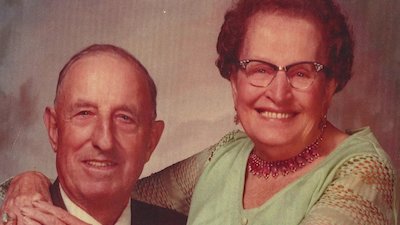The History of the Amityville Horror House to Today
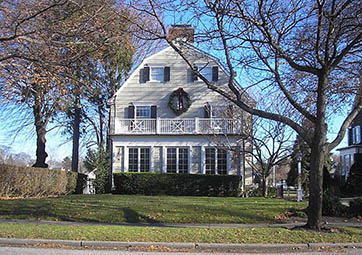
When an emotionally charged paranormal story becomes a bestselling book, movie, and TV show, the original story is often overshadowed. The Amityville Murders (also sometimes referred to as The Amityville Horror) changed the small town of Amityville, NY forever, and became an attraction that draws viewers and tourists–annually.
The National Crime Scene Cleanup (NCSC) is headquartered on Long Island, NY, around 25 miles from where the crime scene occurred. Being in the crime scene cleanup industry and roughly 30 minutes away from the town of Amityville gives a unique perspective, as well as information many non-locals are unaware of.
What really happened at the home starts before the family was shot. The heinous crimes and confusing testimonies told by Ronald DeFeo Jr. overshadowed the many secrets kept by the family. The DeFeo mob ties, the severe physical abuse he put his children through, and the unknown large source of income that allowed them to live a lavish life were greatly overshadowed by DeFeo Jr.’s confessions, testimonies, and questionable mental health.
Table of Contents
- Built in 1927 in Amityville, NY
- The DeFeo Family Move In (1965)
- After the Murders (1974-Present)
- Thoughts from Professional Homicide Cleaners
Built in 1927 in Amityville, NY
In the late 1920s, America was still enjoying the economic boom and growing culture that had its heartbeat in metropolitan New York. The Roaring Twenties allowed metro New York to boom, as did the surrounding metropolitan areas, and the rest of America. The further development of Sunrise Highway helped develop Amityville into a town with schools, a town hall, a library, and surrounding neighborhoods. Most of the surrounding neighborhood was built around the same time the Dutch Colonial Revival architecture horror home was completed in 1927.
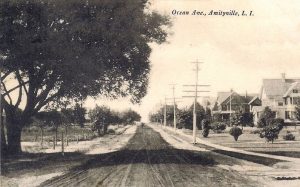
An undated photo of Ocean Avenue, likely taken in the early 20th century given the farmland to the left.
The earliest records of the property state that it was originally farmland owned by the Ireland family, who owned most of the farms in town, and had two streets named after them. Annie Ireland sold the property to John and Catherine Moynahan on January 14, 1924, who built the home on the property. The Moynahans’ had a positive reputation in the neighborhood and happily raised their family in the home. After John and Catherine’s passing, their daughter Elieen inherited the home. After 36 years of belonging to the family with no issues, Eileen sold it John and Mary Riley in 1960. John and Mary Riley had marital problems that ultimately led them to divorce and sell the home to the DeFeo family in 1965.
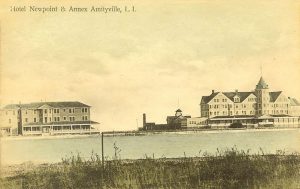
Although the Hotel New Point burned down in the 1950s, it’s still remembered as a historical landmark for bringing NYC residents to the area.
Does Amityville Have A Cursed History?
No, if anything, the area makes it even more confusing. It has never had major issues with crime. As a brief historical overview, like the rest of the country, Amityville was heavily shaped by the Industrial Revolution. It had changed from a strictly rural and fishing community to a suburb of “the City” and a summer resort for the wealthy in NYC. The Long Island Rail Road (then known as the South Side Railway) helped bring new residents and diversify the town’s economy. However, the area’s economy was still dependent on agriculture all year round, even by the 1920s. The area was divided by a working class of farmers, hotels steadily built throughout the early 20th century, and affluent Manhattanites that vacationed there during the summer.
Overall, it was a quiet, peaceful community of just under 4,000, with virtually no violent crime. However, some of the surrounding areas did have some secrets and bloody tales of their own.
Al Capone & His Amityville Residency
Al Capone was a notorious gangster that became prominent during the Prohibition era. Capone had bootlegging plants and a wide network of underground speakeasies completely hidden, all of which he ran throughout the country with help from a Chicago-based gang, the Chicago Outfit.
At least half of America disagreed with the strict Prohibition laws, so Capone was actually received favorably for some time. However, his benevolent image changed when Capone and his gang were suspected of murdering gang rivals in broad daylight on Valentine’s Day in Chicago.
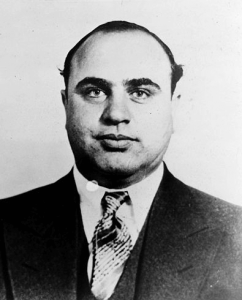
A Photo of Al Capone, c. 1919
Chicago was not the only place affected. Capone and his gangs raised crime concerns all over. Even small remote cities like Minot, ND had earned the nickname “Little Chicago” for its reputation as one of his major bootlegging hubs.
Capone’s operations were very widespread, intricate, and difficult to trace. On the eve of Prohibition, Capone and his wife moved to Chicago in 1919 at the invitation of another crimester. Historical documentation is scarce during this time, especially where crime is concerned, but it is believed that Capone had a residence in Amityville. He likely kept it to be close to “Rum Row”–the line of ships carrying alcoholic beverages during prohibition. In fact, one 1924 issue of the Suffolk County News wrote, “many New York bootleggers have rented bungalows [in and around Amityville] in order to be as close as possible to the base of their supplies.”
Al Capone was eventually convicted of tax evasion and died in prison from a cardiac arrest, likely perpetrated by years of neglect for failing to seek treatment for syphilis. However, his early presence in Amityville helped bolster visibility for future crime families on Long Island.
Although the DeFeo family moved to Amityville in 1965–32 years after Capone had died in prison–the family had similar secrets. The DeFeo family originated in Brooklyn like the Capones’ and Louise DeFeo’s father (Ronald DeFeo Jr.’s maternal grandfather) was a direct associate of the Gambino crime family.
The Great Indian Massacre Near Amityville
Amityville’s lore with violence didn’t start with the mafia or the DeFeo murders. Long before the town was ever incorporated, it was said that the area had seen a fair share of interindigenous violence.
This was especially perpetuated by a medium brought into the home after the paranormal allegations. The medium, Han Holzer, claimed the bad energy in the home stemmed from an angry Indian chief that sought revenge. The claim sounded very similar to other local lore in the area concerning an Indian Princess that kills to avenge her and her lover’s murder at Lake Ronkonkoma on Long Island (roughly 30 minutes away).

The dissipation of the indigenous population has become a manipulated piece of local Long Island history by advocates of racial strife, very similar to the confusion surrounding Thanksgiving.
It is not certain if Han Holzer was correct. It’s important to note that Holzer later wrote three books on the story and worked with DeFeo during the trial to obtain the deal. Historical documentation does not hold records of any violent Indian interaction on the property or the surrounding property. In fact, there are tribes in the area that had peaceful relations with the English, and the English may have even helped or bought the land from them.
However, records do show that Indian massacres did happen on Long Island by the Dutch. The Dutch did not have a skilled army to fight the Indians, thus they hired an Englishman, John Underhill, as the assassin. John Underhill launched the largest killing of Long Island’s indigenous people, slaughtering around 120 in under 24 hours. In 1935, 24 skeletons were dug up at the corner of Merrick Road and Cedar Shore Road in East Massapequa–just 1.5 miles from the Amityville home.
Could there be more to The Great Indian Massacre or was there a separate situation never documented by history? History cannot answer that at this time.
What is known is that while yes, indigenous genocide did happen on Long Island, 75% of the deaths had actually been due to disease. Others migrated or married white settlers or former black slaves.
All in all, from what is known at this current time, the history of the town in the sense of the DeFeo murders may only be relevant where the mafia is concerned. That is, if you believe Butch murdered his family with the assistance of other people.
The DeFeo Family Move In (1965)
In 1965, the DeFeo family moved in. The DeFeo family renovated, landscaped and added a swimming pool. Unlike the Moynahans’ the DeFeo family appeared much more serious and authoritarian. Their family had a noticeably darker approach to life and family than the former owners.
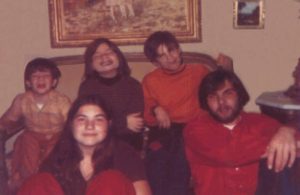
A Family Portrait of the DeFeo children. Left to Right: John-Matthew, Allison, Marc, Dawn, and Ronald Jr.
At the residence, the DeFeo family consisted of:
- Louise Marie
- Ronald Joseph “Big Ronnie”, Sr.
- Ronald Joseph “Butch”, Jr.
- Dawn Theresa
- Allison Louise
- Marc Gregory
- John Matthew
Louise Marie
Louise Marie DeFeo was born in Brooklyn to Michael and Angela Brigante. Blessed with good looks, Louise was an early socialite seen with celebrities such as Mel Torme. Louise aspired to be a model, though those aspirations appeared to dwindle down after she met “Big Ronnie”.
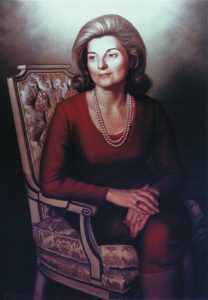
Portrait of Louise Brigante-DeFeo
“Big Ronnie”
Louise met Ronald “Big Ronnie” DeFeo, Sr. likely through her family, as Big Ronnie’s brother was Peter DeFeo, a made member of the Genovese crime family. Louise’s father was also a made man of the Genovese crime family.
Louise took to Big Ronnie as “an attractive and slender man whose gaze resembled Rudolph Valentino”. Big Ronnie’s charming looks certainly drew Louise’s attention despite her feather’s orders to stay away from him. Louise’s father despised Big Ronnie, which caused her to separate herself from the Brigantes. When Louise’s first son with Big Ronnie was born in 1951, Louise and her father reconciled.
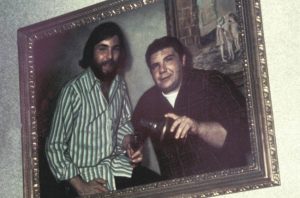
Left to Right: Ronald “Butch” DeFeo, Jr., Ronald “Big Ronnie” DeFeo, Sr.
“Butch”
On September 26, 1951, Ronald “Butch” DeFeo, Jr. was born to Louise Marie and Ronald DeFeo, Sr. As the DeFeos’ first child, son, and namesake of Big Ronnie, Butch had more expected of him than his siblings. And unfortunately, Big Ronnie was known for a quick temper that resulted in verbal and physical abuse. Louise’s brother Michael Brigante Jr. testified about a time he witnessed Butch being physically abused at just two years old.
“We were watching TV and [..] the body had done something. All of a sudden [Big Ronnie] stood up and just pushed the boy […] into the wall. […] banged his head or part of his shoulder or something.” -Michael Brigante Jr. (Source)
Throughout elementary school, Butch struggled with problems due to his weight, perhaps as a result of depression and other undiagnosed mental health issues. He faced issues with bigger kids who would taunt him with nicknames like “the blob”, “pork chop” and “Bucky Beaver.”
Although Butch lost a significant amount of weight during high school as a result of amphetamine abuse, things never seemed to get easier for him, even after his sister Dawn Theresa DeFeo was born when Butch was 6 years old. His mental health and temper continued to plummet, and the physical abuse never ceased inside of the home. However, it was documented that Butch had gotten more violent as his drug use worsened. He began taking heroin, LSD, and demanded more money and possessions, which Big Ronnie tried relentlessly to pacify him with.
Dawn Theresa
Dawn was born on July 29, 1956 in Brooklyn, NY. At the time of the murders, Dawn was 18 years old. Not a whole lot is known about her upbringing or teenage life, but it’s said she also faced physical abuse at the hands of her father, as all her siblings had. Dawn attended St. Martin of Tours Catholic Church with her family and graduated from Amityville Memorial High School. She was enrolled in the Katherine Gibbs Secretarial School in NYC at the time of her death.
Her room and style appeared girly, like that of her sister Allison. In her room, Dawn had flower-styled wallpaper, a pink blanket, and a stuffed animal sitting in a chair. Dawn enjoyed listening to music and kept a record player in her room.
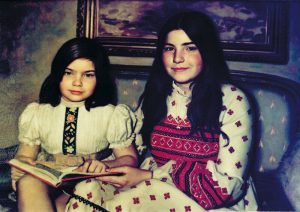
Left to Right: Allison DeFeo, Dawn Theresa DeFeo. Family Portrait.
A Potential Suspect
Dawn has been brought up as an additional potential suspect not only by Butch but also by their maternal grandfather, Michael Brigante, Sr., who testified that he believed his grandson did not act alone in the crime. Brigante hired Herman Race, a supervising NYC police detective, to investigate. Race has also stated more than one gunman existed based on evidence and medical examiner’s findings.
Butch claimed that the night before (November 12) was full of routine physical abuse by his father. He stated that once the scene calmed down he and his sister Dawn went to the basement to “get high”. Butch claimed Dawn was fed up that her father was preventing her from moving to Florida to live with her boyfriend, William Davidge. Indeed, a signed affidavit by Davidge confirmed that Dawn had been trying to move to Florida to be with him and there had been hostile encounters within the family.
Davidge also confirmed that Dawn was taking drugs and like her father, she had a temper that did get out of control. His affidavit also mentioned that he suspected Dawn used Butch as he had witnessed Dawn demand money from Butch. The two had stayed in contact via the phone from Florida to NY.
Butch claimed that his sister had been trying to convince them to kill their parents, which Butch initially refused. After a while of further drug use, the two decided to employ two of Butch’s friends to help. Initial police reports showed that Dawn had burnt gunshot residue powder from her body that may have implied she used a gun, however, no evidence of this or a second gun (a friend’s Colt Python) has been found. Among many of Butch’s claims, like saying he had murdered her in self-defense, he would later contradict himself and say it wasn’t possible for his sister to murder his entire family. A court appointed psychiatrist evaluated him for Antisocial Personality Disorder, of which deceitfulness is a common symptom.
In the end, Dawn’s autopsy determined that she had been shot by a .35 caliber lever action Marlin 336C within 3 inches of the bottom of her neck. The bullet exited through her left ear and her body was discovered lying face down in bed.
Allison Louise
Allison was the third child of the couple and the second daughter of Big Ronnie and Louise. Allison was born on August 16, 1961, which made her 13 years old at the time of her murder. Her room was full of books and jigsaw puzzles. One jigsaw puzzle she had been working on was of the harbor of Eckernförde, Germany.
Allison, or “Allie” as she was sometimes called, attended the St. Martin of Tours Church with the rest of her family members. At the time of her murder, she was not yet in high school and instead attending the St. Martin of Tours Catholic School across the street from her church.
Allie was the childhood friend of one of the police sergeant’s daughters, Patty Cammaroto. Patty’s father, Pasquale Cammaroto, had been present at the crime scene. 20 students of her Catholic church came to mourn Allison and her two younger brothers, Mark and John, at the funeral service.
Marc Gregory & John Matthew
Marc Gregory was the fourth born and second son of Louise and Big Ronnie, born September 4, 1962. Marc was born while the family was still living in Brooklyn. Shortly after his birth Louise took the kids and separated from Big Ronnie for unknown reasons. Big Ronnie somehow serenaded his wife’s return by writing love songs to her like “The Real Thing” and recorded it for Jazz player Joe Williams’ album “One Is a Lonesome Number.”
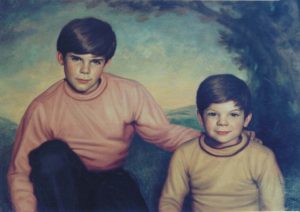
Left to Right: Marc DeFeo, John-Matthew DeFeo. Family Portrait.
The couple reconciled and moved to the affluent South Shore neighborhood of Amityville and had another child, their youngest son John Matthew DeFeo. Born October 24, 1965 John was nine years old at the time of the murders. John wore a “Knicks” sweatshirt that the time of his slaying, and Marc had a pair of crutches and a gray wheel chair near his bed, indicative of the football related injury he had incurred not too long before the murders.
Many wondered how the DeFeos were able to afford to live in an affluent area, able to renovate an already nice home, and afford to take care of four children. The couple also decorated the home with extremely expensive artwork. The family portraits that totaled over $50,000 (around $509,000 in today’s money) and were so detailed that it took over a year for the artist to finish.
How could Big Ronnie afford that lifestyle working for Louise’s father as a Service Manager at a Brooklyn dealership? The answer: Louise’s father covered the costs.
After the DeFeo Murders (1974-Present)
There are many variations of what may have happened during and after the killings. Despite Butch’s confessions that he was the sole murderer, there have been several other conflicting convictions and even speculation by the distant family. Likewise, there’s been a lot of controversy surrounding the property, and the experiences of the families that lived there since.
Per the judge and prosecution, what was determined was that in the early hours of November 13, 1974, Butch retaliated against Big Ronnie’s years of abuse and used a Marlin .35 caliber rifle to shoot him and his mother, Louise, twice. He then moved from room to room, shooting down each of his siblings. Based on the autopsies, it appeared that out of all shot, only Louise and Allison had been awake at the time.
After the murder, Butch explained that he had taken a shower, redressed, and went to work as usual. Around 6:30 pm, he burst into a local bar called Henry’s Bar at the time and shouted, “help me! I think my parents have been shot!” One of his closest friends had been at the bar and helped drive his 1970 Buick Electra 225 with several others to the home at 112 Ocean Avenue for further investigation. His friend burst into the home to discover his parents laying face down in their own blood in their beds. One person from the group called the police, who came and found all six family members dead in the home.
It appeared that Butch had intentionally called for help in hopes that they would assist him with the cleanup, however when the police were called, his plan had went awry. When police asked what happened, Butch initially claimed that the killings were by mob hitman, Louis Falini. Falini had an alibi, however, and Butch had many major inconsistencies with his story. The following day, he confessed to slaying them all himself.
“Once I started, I just couldn’t stop.” –Butch DeFeo
The Lutz Family (1975)
After a little over a year of the home being vacant, the property was placed for sale at a heavily reduced price. The home would’ve been valued at least double the price it was put for sale at–slaying aside. According to the Lutz family, who had thought the house was a bargain when they bought it for $80,000 ($360,000 in 2023 money). For a point of reference, the home today is worth well at least double that amount. In 2010, the home sold for $1.15 mil and in 2016 the home was listed for $850,000.
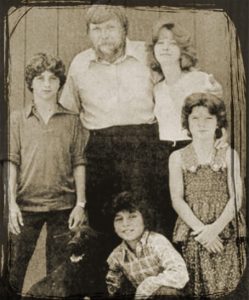
Top Row Left to Right: Daniel Lutz, George Lutz, Kathy Lutz, Melissa “Missy” Lutz
Bottom Row Left to Right: Harry the dog, Christopher Lutz
The Lutz family consisted of:
- George
- Kathy
- Daniel
- Christopher
- Melissa
They also brought their dog, Harry. The family moved into the home on December 18, 1975.
Claims of Paranormal Activity
George and Kathy claimed that there was paranormal activity immediately upon moving into the home, despite previously acknowledging the DeFeo murders and claiming the events would not bother them. They also mentioned the same in a later press conference.
However, the record shows that the family was quickly ushered out of the home 28 days after moving in. They reported strange smells, sounds, cold spots, stains, and slime appearing throughout the home that could not be remedied even with bleach. They also reported flies that swarmed around the home during the dead of winter.
On a separate occasion during Butch’s trial, he claimed he had heard demonic voices from inside the home telling him to kill his family. However, he later recanted this statement, saying that he admitted he heard no voices. However, it could have been his original claim that led the Lutz family to also report hearing demonic voices.
The Lutz family called a Catholic priest to bless the home on several different occasions. One of the priests claimed to have heard voices asking them to stop. The paranormal conditions apparently got so bad that 28 days after they had moved into the home they took a few of their possessions and took refuge at Kathy’s mother’s house in Babylon, NY. They had yet to make a single mortgage payment on the loan.
Shortly after, they returned the property to the bank and signed a deal with an author that wrote the infamous The Amityville Horror (1977). It went on to become a bestselling series in print and media. The series spurred several movies and even a fictional TV series using a fictitious family. The reputation of Amityville has become synonymous with the murders.
The reputability of Lutz’s claims has been disputed, however.
The Cromartys Family (1977)
The Cromartys bought the property from the bank on March 18, 1977. Jim and Barbara Cromartys have publicly denied the Lutz’ allegations that the home is haunted. In fact, during a press conference, the Cromartys stated:
“The quiet village of Amityville, Long Island has been made infamous by a hoax. [..] It is the Long Island’s equivalent to Watergate. None of us would be here if a responsible publisher and author had not given credibility to two liars [..] The credibility of the hoax stems from using a charlatan Catholic priest, who has been banned from performing his religious duties by the Diocese of Rockville Centre. [..] The charlatan priest has been involved with a complicity to a lie and therefore deserves no credibility [..]” (Source)
The Cromartys sued the Lutz, the publishers, and the writer of the book The Amityville Horror (1977) for “invasion of privacy” claiming the statements were made “solely for commercial exploitation.” They eventually settled out of court for an undisclosed amount.
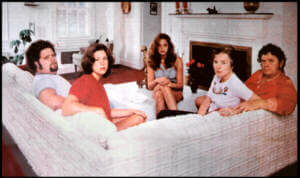
Photo of the Cromartys Family in the living room of 112 Ocean Avenue. (Credit LIMagazine)
The Cromartys made every effort to improve the house’s reputation and improve the reputation of the surrounding community. They even went through the tedious efforts to change the house number from 112 Ocean Avenue to 108 Ocean Avenue, in effort to deter tourists. However, the reputation of the home appeared to outpower all their efforts. They were constantly harassed by tourists, visitors, and onlookers who acted like paparazzi. Eventually, after ten years of harassment and a death in the family, the Cromartys decided to put the house up for sale. In 1987, they sold the home to the O’Neil family.
The O’Neil Family (1987)
Peter and Jeanne O’Neil purchased the home for about $310,000 and stayed in the home for about ten years, from August 17, 1987 to June 10, 1997. They changed the iconic windows to square-styled windows and filled in the DeFeo pool. The O’Neil family never reported any supernatural activity and had an easier transition than the Cromartys’. By the time the O’Neil family purchased the home, the hype and attention to the bestselling series had settled down considerably.
The O’Neil family moved due to property taxes that had risen by over $10,000 a year and wanted to save money to help their children through college.
The Wilson Family (1997)
According to public records, Brian Wilson purchased the home from the O’Neil family on June 10, 1997. Wilson extensively updated and renovated the home, which upped the valuation of the property to over a million dollars. The home’s siding, color, and interior were completely changed and updated, as well as the foundation of the boathouse behind the home. Among the renovations included the addition of a backyard sunroom attached to the home, and property re-landscaping.
The reason for selling the home and the family that purchased the home from the Wilsons’ is private. What is known is that the home was sold in 2010 for $950,000. In 2017, the home was sold again for $605,000 to another private family.
Thoughts From Professional Homicide Cleaners
As professional homicide cleaners of over 20 years, NCSC has seen it all. Looking over the crime scene photos, where you can see the mattresses clearly saturated with inches thick of pooled blood and bodily fluids, we can say we’ve seen situations like these, and situations where the entire room was coated with blood.
Most gunshot situations like the DeFeo murders involve a widespread area of blood that goes beyond the bed, saturating the walls, floors, and even ceilings. The typical situations involve extensive restoration that includes removing floorboards, ceilings, and wall paneling according to protocol. And yes, when a body starts decaying, it does emanate smells that attract the appearance of flies (particularly blowflies). Blowflies survive all year, and when they nest in homes, they can survive in walls or heated areas of the home in hidden nests.
There have also been cases where some of our colleagues have felt uncomfortable based on the type of situation–namely, feeling like there was a presence in the home, some sort of entity or energy even when it was apparent that it was just our crew working. However, the allegations that the home had green slime coming from the walls seem like a stretch, even for our cleaners, who are exposed to extreme conditions every day.
To address some of the Lutz’ claims, it is important to note:
- Again, blowflies can live all year round, even in December, as long as they have a heat source within the home.
- Improper biohazard cleanup can leave residue within walls that does emanate a smell.
- Legal procedures for biohazard cleanup weren’t legalized until 1976, three years after the murders, and a year after the Lutz vacated the home.
- The Lutz’ bought the home with the DeFeo’s furniture for $400 as part of the mortgage agreement. If any of the furniture had missed cleaning or been improperly treated, it can emanate smells that cause emotional trauma.
- Since federal biohazard legislation was near nonexistent at the time, it’s possible that there was remaining biohazard soaked into the different infrastructure of the rooms, and blowflies had been feeding and nesting off it from in the 47-year-old infrastructure of the home.
- Decomposition smells can be harrowing, emotionally traumatizing, and have even been proven to activate a fight or flight response in the body.
- It isn’t clear to what extent the home had been restored at the time the Lutz family moved in. At such a low price, it can be indicative of the work done, especially given there was nothing in federal or state law protecting the family or the environment from what we understand as dangerous, pathogenic biohazards.
No matter how you look at it, or what you believe about the home, the DeFeo murders were a serious tragedy, one that has been deeply felt by the local Long Island community, and even nationwide. NCSC prays for the families or close friends of those involved, as well as the victims of this tragic crime.
—-
Interested in reading more true crime? Read about the other famous murders that changed America.




